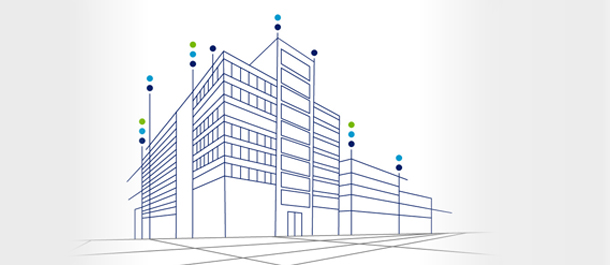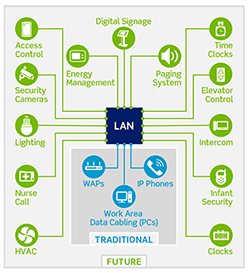Take a Smart Approach to Smart Buildings

For years, conversations about network "convergence" mainly involved the combination of voice and data work area applications onto one network. The local area network (LAN) consisted of work area cabling to support PCs on the desk, and IP phones were eventually added. More recently, wireless access points (WAPs) were added to support mobile devices such as laptops, cell phones and tablets.
Now, building systems such as HVAC, lighting, security systems and energy management systems are being incorporated into the LAN, a trend referred to as "intelligent" or "smart" buildings. The global smart building market is expected to show a compound annual growth rate of more than 34% between 2017 and 2024, according to the 2018 Global Smart Building Market from Zion Market Research.

There are various reasons for smart building initiatives, but primarily it is to allow for better management, improved visibility and increased efficiency of operation. Therefore, the IP network is being asked to support a much larger footprint of applications and becoming integral to the performance and management of business operations. This undertaking can bring challenges and complex choices that aren't always apparent at the outset.
These challenges include:
- With additional devices added to the LAN, there's a wider range of bandwidth and data-rate needs. In addition, devices have different power requirements. Lighting or wireless access points might require 60 watts or more, while simple badge readers or access control devices may only need 15 - 30 watts.
- Devices are no longer all located at a desktop. They can be located throughout a building or campus, so a lot more pre-planning and analysis must be completed as part of the design.
- Technology is evolving so quickly that many of today's designs might not support the new solutions of tomorrow, and new technologies may expand the need for structured cabling into additional areas of the building well beyond what is envisioned today.
UNDERSTANDING REQUIREMENTS
When Leviton advises customers on the types of cabling they need for connecting intelligent devices, we group applications into three areas that have their own distinct requirements:
High Bandwidth / High Power
Typical applications requiring high bandwidth and high power include wireless access points and video conferencing systems. These applications will require upwards of 10 Gb/s of data and Power over Ethernet at 60 watts or higher. This makes Cat 6A cabling a must, with its ability to support 10GBASE-T. Also, Cat 6A cable and patch cords have larger conductors, which heat up less and perform better under power than small conductors.
Low Bandwidth / High Power
Devices requiring less bandwidth but high power include lighting and security cameras with advanced features, such as heaters, tilt, and zoom functionality. There are a couple of options for this category. The most cost effective would be to use newer Cat 5e cables on the market that have 22-gauge conductors (as opposed to the typical 24-gauge offering for Cat 5e). These are most efficient at delivering power and still support 1 Gb/s data transmission. By selecting Cat 5e cable, it also allows for selection of more cost-effective Cat 5e connectivity.
A Cat 6 system could also be used, as typical Cat 6 cable has 23 AWG conductors to handle higher power, while supporting 1 Gb/s. It is not quite as efficient for power delivery as using a larger 22-gauge conductor, and the system of cabling and connectivity will likely cost more than a Cat 5e solution.
Low Bandwidth / Low Power
Typical applications for this include building automation (e.g., thermostats) and security access controls. With low bandwidth and lower power requirements, a Cat 6 or Cat 5e system with 24-gauge or 23-gauge conductors are ideal.
It's wise to anticipate what the second and third generation of technology will be needed for your building or facility. Perhaps the applications you use today only require low bandwidth and low power, but will that continue to be the case? While building technology, servers and endpoints are upgraded every three to five years on average, the cabling plant is typically only updated every 10 or more years. So it is quite possible that the cabling you select today will need to support three generations of technology.
Read more about smart building design and planning in our white paper Cabling System Planning and Design for Smart Buildings »


